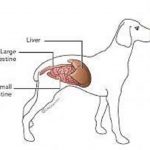
Photo by Dr. Teri Ann Oursler
Cat owners whose pets have been diagnosed with fatty liver or for whom fatty liver is being considered as a possible complication of another problem can use some information. Briefly, lipidosis is considered as a cause or contributing cause of liver failure when a cat that was once overweight loses weight too quickly. Often the owner is not aware that such a thing is dangerous and is pleased to see the obese cat trimming down. By the time the cat actually stops eating and is clearly sick, the disease is well underway and will require more aggressive support to reverse. The good news is that there is a good recovery rate for this condition provided it has not progressed too far.
Unexplained weight loss is never good. Have the cat evaluated before she becomes overtly sick.
The average cat with lipidosis is middle-aged, was at one time obese but has lost at least 25% of its original body weight, has a poor appetite, and may have an obvious upset stomach (38% will have vomiting, diarrhea or constipation). Cats that are especially weak may have concurrent electrolyte imbalances or vitamin deficiencies from their liver disease.
In lipidosis, there is frequently a bleeding tendency that can make harvesting a biopsy sample somewhat risky. If ultrasound is suggestive of lipidosis, it is generally safer to take a needle aspirate rather than a biopsy sample, which is a bigger bite of tissue. An aspirate showing fat infiltration is usually diagnostic, especially when ultrasound shows the entire liver with a fatty texture.
The Cat In Liver Failure
The cat in liver failure is jaundiced, frequently nauseated, will not eat and generally is an obviously ill animal. The jaundice (more clinically termed icterus) is often not noted by the pet owner but can be seen by carefully examining the whites of the eyes for yellow coloration. Sometimes the yellow color is not evident to the naked eye but the trouble is picked up as a blood test elevation in bilirubin, a yellow pigment normally kept in check by the liver. Alternatively, the urine of an icteric cat will look bright orange or even brown as bilirubin builds up.
If the bilirubin is not elevated on the blood test, liver disease may be picked up as an elevation in a blood test enzyme called alkaline phosphatase (ALP). This enzyme should never be elevated in cats under any normal circumstances though there are several forms of this enzyme and an elevation does not necessarily indicate liver disease. An ALP elevation is definitely suggestive of liver disease and requires follow up testing such as a bile acids liver function test. Other liver enzymes commonly monitored on routine blood panels are alanine aminotransferase (ALT) and aspartate animotransferase (AST). These enzymes elevate relatively easily and are not as important in liver evaluation as ALP elevations but a substantial increase may also warrant follow up liver testing. In the event of hepatic lipidosis, also called fatty liver, the elevation in ALP is often dramatic.
Liver Disease Vs. Liver Failure
It is important to distinguish tests of liver damage (like enzymes) versus tests of liver function (like bile acids). The enzymes ALT and AST are normally held inside liver cells; when their presence is detected free in the bloodstream, this is an indicator of liver cell death. A liver can have damage without any decrease in its overall function.
A liver function test is different. In a liver function test, the liver is actually asked to do something (generally process a biochemical in a detectable way). In this way, we can see if the liver is actually in need of support and whether or not we have a good chance of getting a diagnosis through a biopsy. Tissue sampling such as biopsy or needle aspirate is crucial to the diagnosis of liver disease. Without a tissue sample, all we can tell is whether or not the liver is in failure and specific therapy for a specific type of liver disease is not possible (though general support of the failing liver may still be possible.)
A typical sequence in the diagnosis of this condition would be:
- Cat is obviously sick and sees the vet.
- Cat may show the yellow pigment changes typical of liver disease (70% of cats with lipidosis have jaundice).
- Routine blood tests show marked ALP elevations.
- Bile acids are elevated (testing bile acids is not necessary if bilirubin is elevated).
- Ultrasound shows a disease process involve the liver in its entirety.
- A needle aspirate or tissue biopsy shows hepatic lipidosis.
Fatty Liver (Hepatic Lipidosis)
A fatty liver can develop in as soon as two weeks with an appetite reduction of 50-75 percent.
The so-called fatty liver is one of the most common causes of liver failure in cats and it stems from the cat’s basic design. Cats evolved as predators of small birds and rodents, eating multiple small meals throughout the day. Their physiology is geared towards a completely carnivorous diet and with the presupposition that cats would live lean and never have the opportunity to develop extensive fat stores.
Of course this all changed when cats become domestic. The modern housecat has every opportunity to become overweight and while this may not be of disastrous consequence on a day to day basis, should the cat get sick or lost and stop eating, a big problem erupts. The fat stores mobilize. Normally, in starvation, fat is moved from the body’s storage depots to the liver for processing into lipoproteins but the feline liver was never intended to handle huge amounts of mobilized fat. The liver becomes infiltrated with fat and fails. Complicating matters are the high dietary protein requirement that is unique to cats; protein malnutrition develops very fast when cats do not eat.
Why Would a Cat Stop Eating in the First Place?
Initially there was an underlying cause of the decrease in food intake that started the cat down the slippery slope to lipidosis. If you’re lucky, the underlying cause has resolved (such as the cat was lost/starved and has now been found). It is important to keep in mind that even though lipidosis usually carries a fair prognosis, in more than 90 percent of cases there is a second condition that requires attention, one with a prognosis that might not be so fair.
Cornell University looked at 157 cats with lipidosis and looked at what conditions were primary. Here is a summary of what they found:
- 28% had inflammatory bowel disease
- 20% had a second type of liver disease (usually cholangiohepatitis)
- 14% had cancer
- 11% had pancreatitis
- 5% had social problems (new cat, new home, threatening other pet or person at home)
- 4% had some kind of respiratory disease
- 2% were diabetic
A lab test that might be helpful in determining underlying cause is the GGT (gamma-glutamyl transpeptidase) level. It is usually not elevated in lipidosis but would be elevated if there is an underlying additional liver disease or in the event of pancreatitis.
Treatment
The cornerstone of treatment for lipidosis involves aggressive nutritional support. A high protein diet must get into the cat to reverse the metabolic starvation state. If this is done carefully, the recovery rate approaches 90 percent.
Getting the Food In
Generally, by the time a cat has gotten into trouble with hepatic lipidosis, most owners have already tried tempting cats with assorted favorite foods and gotten no results. At the point where lipidosis has developed, the cat should not be given a choice about eating; there are several methods of providing food you can enlist.
Nasogastric Tube

A feeding tube can be passed through the nose, down the esophagus, and sewn into place to allow feeding of a liquid diet. Placement of this kind of tube does not require anesthesia, and the tube is relatively easy to use. Some problems are associated with this type of feeding tube. For example, the tube can be dislodged by an errant paw, necessitating replacement; an Elizabethan Collar is necessary to protect the feeding tube. Further, only liquid diets can be fed through the tube due to its small diameter. The tube can also be pushed backward after a vomiting attempt so that it opens towards the mouth instead of the stomach. All of these problems make the N-G tube the least popular of all the feeding tubes when it comes to long term use; however, often this form of feeding is used for the first few days as this is when bleeding risk is highest and the patient is least stable for anesthesia. One of the other tubes can be placed when the patient is more stable.
Esophagostomy / Pharyngostomy Tubes

The esophagostomy or pharyngostomy tube is easily placed with short-acting anesthesia and sewn in place, creating a feeding tube that exits the side of the neck. A bandage or padded collar is placed to hold the tube in position and keep it from catching on things, though the tube is comfortable enough that an Elizabethan collar (plastic cone collar) is not necessary. The cat can be mobile with comfort and the diet can be slurried or blenderized as the tube is larger than the nasogastric feeding tube. The tube must stay in place for at least two weeks but can stay in place for many months if necessary. The tube does not interfere with eating normally when the cat starts to recover interest in food.
Stomach Tube
These tubes can be placed via an endoscopy or a special applicator called an Eld gastrostomy applicator. This tube is placed under general anesthesia but ultimately of all the feeding tubes is the most comfortable to wear. A bandage around the belly protects the tube, which must stay in place a minimum of two weeks but can stay in place as long as a year (maybe longer, though the treatment of lipidosis requires generally 4 to 6 weeks or so of tube feeding).
Be sure the food you are using is made for cats. Human liquid diets may be deficient in some of the specific amino enzymes required by cats for recovery.
Ask your veterinarian about diets that fit the high protein profile best for lipidosis cats. Commercial diets are available.


